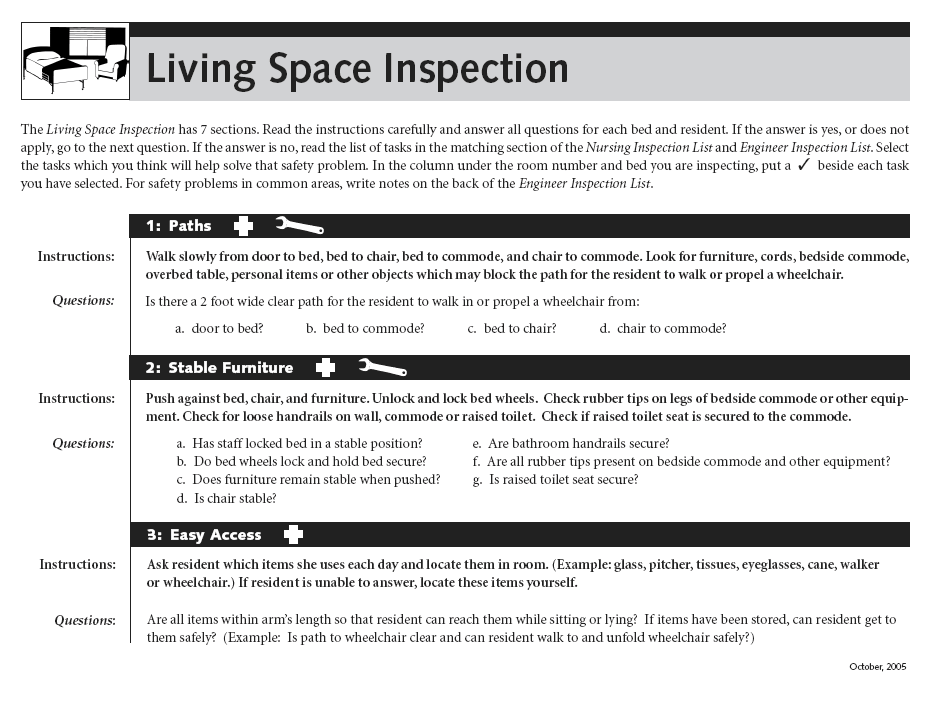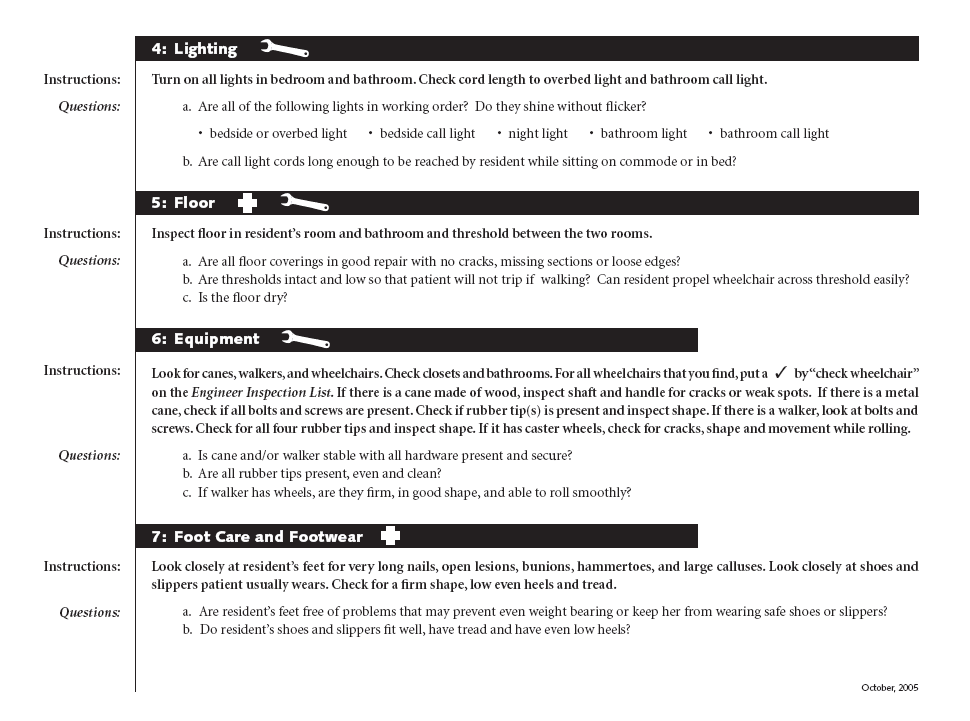Text Description of Form
The Living Space Inspection has 7 sections. Read the instructions carefully and answer all questions for each bed and resident. If the answer is yes, or does not apply, go to the next question. If the answer is no, read the list of tasks in the matching section of the Nursing Inspection List and Engineer Inspection List. Select the tasks you think will help solve that safety problem. In the column under the room number and bed you are inspecting, put a √ beside each task you have selected. For safety problems in common areas, write notes on the back of the Engineer Inspection List.
1: Paths  |
||
|---|---|---|
| Instructions | Walk slowly form door to bed, bed to chair, bed to commode, and chair to commode. Look for furniture, cords, bedside commode, overbed table, personal items, or other objects that may block the path for the resident to walk to propel a wheelchair. | |
| Questions: |
Is there a 2-foot wide clear path for the resident to walk in or propel a wheelchair from: a. door to bed? b. bed to commode? c. bed to chair? d. chair to commode? |
|
2. Stable Furniture  |
||
| Instructions: | Push against bed, chair, and furniture. Unlock and lock bed wheels. Check rubber tips on legs of bedside commode or other equipment. Check for loose handrails on wall, commode, or raised toilet. Check if raised toilet seat is secured to the commode. | |
| Questions: | a. Has staff locked bed in a stable position? b. Do bed wheels lock and hold bed secure? c. Does furniture remain stable when pushed? d. Is chair stable? |
e. Are bathroom handrails secure? f. Are all rubber tips present on bedside commode and other equipment? Is raised toilet seat secure? |
3. Easy Access  |
||
| Instructions: | Ask resident which items s/he uses each day and locate them in room. (Example: glass, pitcher, tissues, eyeglasses, cane, walker or wheelchair) If resident is unable to answer, locate these items yourself. | |
| Questions: | Are all items within arm's length so that resident can reach them while sitting or lying? If items have been stored, can resident get to them safely? (Example: Is path to wheelchair clear and can resident walk to and unfold wheelchair safely?) | |
4. Lighting  |
||
| Instructions: | Turn on all lights in bedroom and bathroom. Check cord length to overbed light and bathroom call light. | |
| Questions: |
|
|
5. Floor  |
||
| Instructions: | Inspect floor in resident's room and bathroom and threshold between the two rooms. | |
| Questions: |
|
|
6. Equipment  |
||
| Instructions: | Look for canes, walkers, and wheelchairs. Check closets and bathrooms. For all wheelchairs that you find, put a [check] by "check wheelchair" on the Engineer Inspection List. If there is a cane made of wood, inspect shaft and handle for cracks or weak spots. If there is a metal cane, check if all bolts and screws are present. Check if rubber tip(s) is present and inspect shape. If there is a walker, look at bolts and screws. Check for all four rubber tips and inspect shape. If it has caster wheels, check for cracks, shape, and movement while rolling. | |
| Questions: |
|
|
7. Foot Care and Footwear  |
||
| Instructions: | Look closely at resident's feet for very long nails, open lesions, bunions, hammertoes, and large calluses. Look closely at shoes and slippers patient usually wears. Check for a firm shape, low even heels and tread. | |
| Questions: |
|
|
Image of Form





